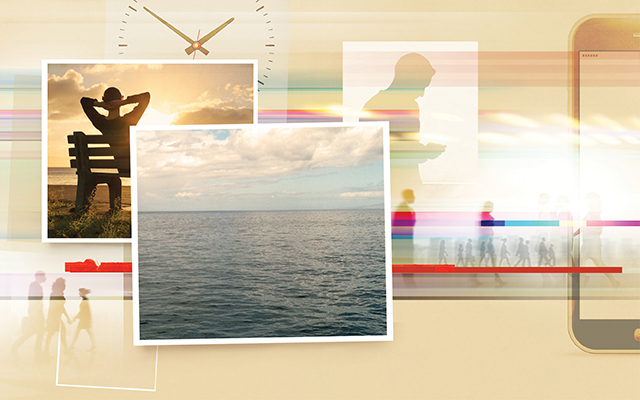My dog, Wabi, lives for his daily walk. The word alone sends him into a tailspin of delight. Yet he spends most of our outings pulling at the limit of his leash, desperate to get to the next yard, next corner, next fire hydrant. He careens from hosta to street sign as if in a sniffing version of a hot-dog-eating contest. Technically, we’re not going anywhere — the walk is the destination — but this doesn’t slow him down one bit.
Truth be told, I often go through my days the way Wabi approaches his walks, rushing from one task to the next, looking forward to crossing items off my to-do list even as I’m doing them. And it’s not just onerous chores I hurry through, either. I’m often thinking three steps ahead even while enjoying what’s supposed to be a nice, relaxing meal.
My dog and I aren’t the only ones in a rush. For many of us, the habit is reinforced by nearly every aspect of our modern lives. From speed reading and speed dating to the ever-increasing speeds of the little supercomputers we carry in our pockets, the overwhelming directive of American culture seems to be, Hurry!
Web-browser extensions increase the speed of online videos’ playback time, lest we watch too few YouTube offerings in any given hour. Instead of broadcasting alarming new headlines every 24 hours, news outlets now drop bombshells every 24 minutes.
“The world is a giant smorgasbord of things to do, consume, and experience, and we want to have it all,” says journalist Carl Honoré, author of In Praise of Slowness. “The problem is that having it all is a recipe for hurrying it all.”
Even our bodies change in response to this harried environment. In his book Timeshifting, Stephan Rechtschaffen, MD, explains “entrainment,” a law of physics that compels disparate rhythms to ultimately synchronize. Two pendulums swinging in different cadences, for example, will eventually sync up if placed side by side. Rechtschaffen argues that we are similarly inclined to sync up with the accelerating pace of life.
“We no longer entrain to the sounds of birds [or] the waves on the shore. Today instead we move to the rhythms of computers,” he writes.
“We’re in a tunnel,” explains Robert Butera, PhD, author of Meditation for Your Life. “We’re not aware of how fast we’re going, because everything around us is humming that way.” It takes concerted effort, he says, to resist the pressure and learn to slow down.
Where’s the Fire?
It’s not only outside forces that keep us moving faster than necessary. Many of us rush because we’re chasing some anticipated moment of happiness: If I can just finish writing this article, driving through rush hour, and get dinner on the table, then I can relax and feel good.
But when our internal clocks are still madly ticking, we can’t fully enjoy the experiences we’ve hurried to create for ourselves. “As the pace of our lives grows faster and faster, our definition of a ‘moment’ grows shorter and shorter, moving our awareness of time into ever-tinier increments,” Rechtschaffen notes.
“By cramming each moment so full of events, we leave ourselves no time to actually experience them in any meaningful way.”
Without making a conscious effort to downshift and entrain to a slower rhythm, we may end up watching our lives pass by in a monotonous wash, leapfrogging the present moment and anxiously awaiting the next.
For some of us, speed is just a defense mechanism. Many experts suggest that what we really fear is not wasting time, but encountering empty moments in which we might come face-to-face with feelings we’d rather ignore.
“People stay in a rush because it’s easier,” says New Jersey–based psychologist Leslie Becker-Phelps, PhD. “There are things they’d have to face if they slowed down.”
It’s not just emotional discomfort that gets stifled, either. When we avoid confronting sadness or regret, we’re also likely to miss out on wonder and delight. Rushing is not a selective anesthetic.
This superficiality can weaken our most important relationships, and when those suffer, so does our health. Deep social connections have been shown to increase longevity, strengthen the immune system, and support cognitive functions. But they take time — and attention — to build and sustain.
We may think social media can help us connect on the fly with more people, but a recent study found that heavy usage can increase feelings of loneliness and isolation. For me, spending an hour “liking” 20 acquaintances’ photos online doesn’t remotely confer the same sense of warmth and connection I feel after spending 10 minutes talking with a friend in person.
Rushing to Slow Down
Even when we try to slow our internal rhythms, it can end up being counterproductive. More than once, I’ve found myself careening into the parking lot of my yoga studio with a racing heart and clenched jaw, trying to make it through the door and onto my mat on time. (Here’s a riddle: Just how much yoga does it take to undo the stress of constantly running late to yoga?)
“Culturally, there’s a lot of pressure to do more and be better,” says Becker-Phelps. “Even self-improvement is often about doing more, as opposed to practicing more self-acceptance and simply being in the moment.”
If you’re cramming your schedule with ever more activities and commitments that you’re scrambling to meet, even ones geared toward relaxation, Butera suggests you may be running from something. “Rushing can be a version of addiction,” he explains. “Adding a yoga class or some other intervention can just be a way of perpetuating it.”
Consider whether you’re trying to prove something or please somebody, or whether your sense of self-worth might be dependent on rushing around. “You can’t break the pattern without understanding it,” Butera says.
Becker-Phelps agrees. “Slowing down is a life-perspective change, and that’s harder than learning a technique or two.”
Find the Balance
I will probably never drift serenely down a sidewalk. My mother called me “Loper” after she became weary of trotting to keep up with me when I was a kid. But slowing down isn’t simply a matter of pace; it’s a matter of presence and awareness — and those are things any of us can practice.
“Finding balance in life is similar to riding a 20-speed bicycle,” observes Rechtschaffen. “True success, deep satisfaction, and longevity are promoted by learning to shift gears to find the best rhythm for each moment.”
That means you can be mindfully brisk as long as you consciously choose to shift into high gear. “The problem is [that] when your brain is pushing faster than your body, it gets disconnected from the moment,” says Becker-Phelps.
We don’t need to spend so much of our time straining at the limits of our leashes, mindlessly gobbling up maximum stimuli and racing to the conclusion. Consciously noting our pace and its effect on our surroundings isn’t always easy, but the stakes may be nothing less than our ability to feel fully alive.
Just as the clock seems to speed up when we operate from a place of scarcity (not enough time, not enough pleasure, not enough productivity), slowing our internal metronome invites a sense of abundance.
To that end, here are a few practical tips to help you start slowing down and enjoying the luxury of now.
5 Ways to Slow Down
 Illustrations by Cliff Alejandro
Illustrations by Cliff Alejandro1. Take the Long View
When you feel yourself reacting to some external stimuli with an impulse to speed up, push pause. “During this brief time-out, imagine yourself looking back on this ‘crisis’ a year from now,” says Honoré, “and notice how insignificant it will look then.”
Becker-Phelps offers a similar suggestion. “Ask yourself: At your 100th birthday party, how will you feel good about having spent your time?” she says. This can help clarify your priorities and bring a wiser perspective to your current urgency.
Once you’ve sorted out what’s truly important to you — family time, meaningful work — you can choose to make more room for those experiences and learn how to savor them.
2. Make Time by Doing Less
“We have a deep-seated conviction that more work, more enrichment activities for the kids, more likes on Facebook or Instagram, more stuff would be better,” writes Christine Carter, PhD, a senior fellow at the Greater Good Science Center at the University of California, Berkeley, and author of The Sweet Spot: How to Accomplish More by Doing Less. But, she adds, “unless we like feeling exhausted and overwhelmed, we need to accept that more is not -necessarily better.”
Carter recommends taking the minimum effective dose (MED) approach to activities in your life — spending the minimum amount of time on checking email, meditating, and exercising that you need to feel effective and balanced — and liberating yourself from other people’s expectations or demands on your time.
3. Schedule Unstructured Time
Honoré suggests picking consistent times of the day when you switch off all technology. Maybe it’s at dinnertime or in the hour before going to bed. He also advises incorporating a slow ritual into your day. Whether it be yoga, gardening, reading a novel, sketching, or playing an instrument, choose an activity that “inoculates you against the virus of hurry.”
Butera notes that nature is particularly effective at entraining us into a slower rhythm. “Go into nature with no devices,” he advises. He also recommends taking one day a week away from all technology, wherever you are. “We all need a regular tech sabbath.”
4. Check In
“Stop at random moments throughout the day and ask yourself if you’re going too fast,” advises Honoré. “If you are, return to the task or the moment more slowly.” If you find yourself automatically reaching for your phone at a red light or in the middle of a conversation, pause, notice the impulse, and imagine it’s an ocean wave you’re surfing, using your breath to maintain balance as the wave rises and eventually subsides.
5. Build a Buffer
Slowing down can be tough if you’re afraid you won’t live up to your obligations. “We pack in events so tightly that we end up running from one thing to the next,” says Honoré. “Or we go into firefighting mode, because even the slightest delay can throw off our tightly wound schedules.”
You can avoid this simply by building in more time between commitments. If you normally schedule 10 minutes to get from point A to point B, allow yourself 15 minutes instead. If you do find yourself running late, remember that it’s not worth the danger of speeding or driving erratically. It’s better to arrive at your destination 30 seconds late than in the afterlife 30 years too early.
Learning to slow down might be tricky at first, but let’s face it: The time we have on Earth is limited. Shouldn’t we do all we can to enjoy it while we’re here?
How to Be Mindfully Swift
As any athlete or surgeon knows, there are times when speed is of the essence. When the stakes are high and it’s time to move, it’s even more important to operate with a high degree of focus, awareness, and intention. These strategies can help.
Call it what it is.
Acknowledge that you’re purposely and intentionally choosing this moment to work, move, or think quickly. This keeps it from being a default mode you slip into unnecessarily when you’re stressed or distracted. One study found that mentally labeling our emotional states can diminish activity in the amygdala and parts of the limbic system related to stress and anxiety. Simply telling yourself that you’re rushing can invite more ease, even if you don’t slow down.
Keep breathing.
Bring awareness to your breath. Is it increasing in rate? Becoming more shallow? Consciously lengthening and deepening your breath will supply your brain with the oxygen it needs to maintain focus and calm.
Break it down.
You need to get from right here to over there in a hurry, but there are 100 steps along the way and you can take only one at a time. Rather than thinking three steps ahead, bring a calm, laser focus to the one you’re on.
“If you’re on your way to a meeting, you don’t need to be going over your list,” says psychologist Leslie Becker-Phelps, PhD. “Even as you travel across town, you can be aware of your environment, your internal feelings, and the people around you. You can notice that beautiful flowering plant.”




This Post Has 0 Comments